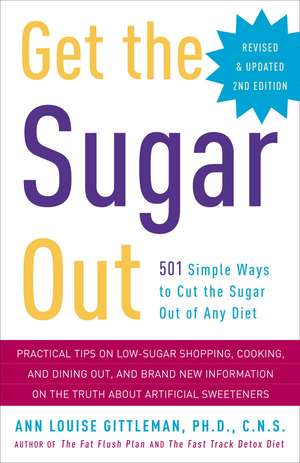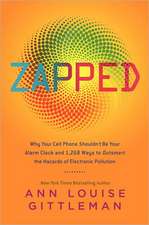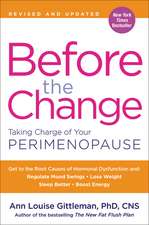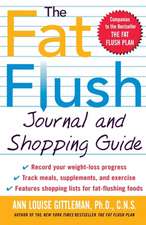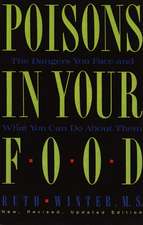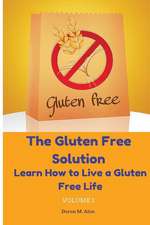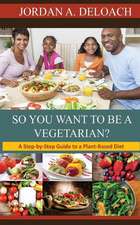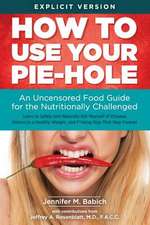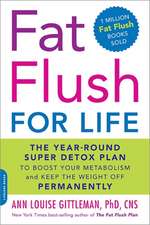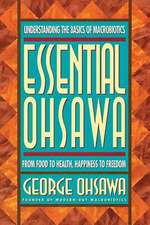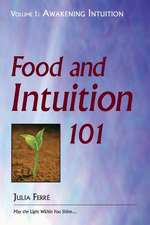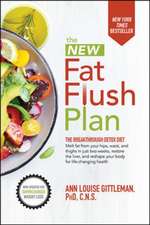Get the Sugar Out: 501 Simple Ways to Cut the Sugar Out of Any Diet
Autor Ann Louise Gittlemanen Limba Engleză Paperback – 31 dec 2007
• Eat more meals at home, so you can oversee the ingredients and avoid hidden sugars
• If you have a sweet tooth, try tricking it by chewing on a cinnamon stick
• Be a food detective; don’t trust “sugar free” or “fat free” labels
• Cut down on salt not only to be healthier but because it helps cut out sugar cravings
• Don’t exchange sugar for artificial sweeteners; as you’ll find out here, many are harmful
With type II diabetes at an all-time high, cutting sugar from your diet is imperative. Get the Sugar Out is your solution for treatment and prevention: a unique, practical guide to a healthy and happy low-sugar lifestyle.
Preț: 106.23 lei
Nou
Puncte Express: 159
Preț estimativ în valută:
20.33€ • 21.20$ • 16.90£
20.33€ • 21.20$ • 16.90£
Carte disponibilă
Livrare economică 28 februarie-14 martie
Preluare comenzi: 021 569.72.76
Specificații
ISBN-13: 9780307394859
ISBN-10: 0307394859
Pagini: 287
Dimensiuni: 133 x 202 x 15 mm
Greutate: 0.22 kg
Ediția:Revised.
Editura: Three Rivers Press (CA)
ISBN-10: 0307394859
Pagini: 287
Dimensiuni: 133 x 202 x 15 mm
Greutate: 0.22 kg
Ediția:Revised.
Editura: Three Rivers Press (CA)
Notă biografică
ANN LOUISE GITTLEMAN, PH.D., C.N.S., is a respected, visionary health pioneer, weight-loss expert, and award-winning author of twenty-five books, including the New York Times bestseller The Fat Flush Plan.
Extras
Chapter 1
Get the sugar out of your kitchen
Many sugar-cutting tips have multiple uses. Once you learn them, you can use them when making breakfast, lunch, dinner, snacks, and yes, even healthful desserts. They can be utilized time and again until they become habits and maybe even family traditions.
The tips in this chapter are the ones you should begin with. They are fundamental sugar-busters--basic concepts to help you identify sugar in all its various forms and to teach you to limit, substitute for, or eliminate it in the foods you put in your grocery cart, the foods you have in your kitchen, and the way you prepare food.
Start the way that suits you best. Most people like to ease into changes, so begin by remembering the concepts and using the tips that seem the simplest and most appealing to you. Once those become second nature, you'll be more apt to try some of the others.
Lifestyle changes such as cutting the sugar out of your diet have a much better chance of taking root when you know exactly how and why you should make those changes. The tips in this chapter cover those hows and whys and serve as the foundation for all of the other tips in this book. Get to know this chapter well, and remember that the efforts you are putting in today will pay off in rewards to your health tomorrow.
top ten tips
1.The very easiest way to cut sugar is to stop adding it to foods such as cereal and fruits and to drinks such as herbal tea, coffee, and coffee substitutes. Simply eliminating nutrient-empty processed sugars from your kitchen is a good way to start. This means not only table sugar but dextrose, raw sugar, turbinado sugar, brown sugar, and powdered sugar as well.
2.Eliminate processed carbohydrates from your kitchen. Although many people don't realize it, refined carbohydrates such as white rice, white bread, and white pasta are quickly converted to sugars in the body and disrupt the body's blood sugar and fat control systems. Keeping these common products out of your home is a simple yet effective way to maintain a better-balanced blood sugar level.
3.Stick with unprocessed whole foods. That's the only way to be sure you're greatly reducing your sugar intake. Poultry, meat, fish, and eggs are, of course, sugar-free, and legumes, grains, nuts, vegetables, and fruits, which may have some naturally occurring sugars, are full of nutrients and fiber, two ingredients that help balance blood sugar.
4.Thin out sweeteners or sweet foods, even natural ones, whenever you can. The idea isn't to substitute one sugar addiction for another one, but rather to gradually and permanently cut down on all forms of sugar in your diet. Dilute concentrated sweeteners such as honey with water and mix sweet foods like granola with unsweet foods such as plain cereal and nuts to reduce the total amount of sugar consumed.
5.Just as with sugar-free foods, beware of fat-free foods. The fat-free trend of the early 1990s predated the low-carb craze from which we are now emerging. "Fat-free" may be in bold letters on the label, but what the manufacturers don't tell you is that the products are sugar-rich, sometimes containing two or more times the sugar found in the regular version of that product that naturally contains a little fat. High amounts of sugar not balanced with protein and fat cause the pancreas to release insulin, the body's main fat-storage hormone. Fat-free products may sound good on paper, but in the ultimate irony, fat-free products helped to make Americans fatter and can still do so if you eat them excessively.
6.The more natural the food, the better. It's well established now that the more processed a food is, the more it will tend to raise your blood sugar. Since balanced blood sugar levels are the goal, opt for foods as close to their natural state as possible. Choose an orange in place of orange juice, an apple over applesauce, and brown rice instead of white rice.
7.Become a food detective. To reduce sugar, you have to know where it is first. To do that, you have to be alert, ask questions, and pay attention to the information you receive about food. Learn to recognize important clues--such as how many grams of sugar are listed on a food label, the ingredients in a food, and how sweet a food tastes to you. Once you identify those foods with a high or hidden sugar content, you know them for what they really are: nutrient robbers and troublemakers for your body.
8.Eat for taste and good nutrition, not just taste alone. Your tastes can change, after all, but your fundamental nutrient requirements have to be met each and every day. It's far better to have your taste buds rebel for a short while than to have your body break down from nutrient deficiencies. Keep this in mind when you're asked to change long-standing habits for new, healthier, sugar-reducing ways of eating.
9.Listen to your body. One of my earlier books, Your Body Knows Best, goes into this subject in more depth, but for now, know that your body gives powerful signals about what's right for you even when your taste buds don't want to listen. For example, if you get an initial high after eating a piece of chocolate but two hours later feel lethargic, irritable, and depressed, your body is going to great lengths to tell you something. Try to pick out those foods that make you feel good over the long term--mentally, emotionally, and physically--and you'll make great strides toward stabilizing your blood sugar.
10.Eat regular, balanced meals. This may sound like old-fashioned advice, something your mother might have told you, but scientific research is proving its inherent wisdom. Some research indicates that the body operates more efficiently when each meal or snack that you eat contains approximately 40 percent carbohydrates, 30 percent protein, and 30 percent fat. This formula keeps your blood sugar in the optimal zone for as long as four or five hours. Balanced blood sugar levels mean better concentration, better mood, and greater energy and stamina (and therefore less need or temptation to grab something sweet for quick energy).
tricks of the trade
11.Try an elimination diet, cutting out sugar in all forms (even natural sweeteners such as fruit and fruit juice) for two weeks. This is important as a gauge to help you determine your relationship with sugar. During the two-week period, stick to just poultry, fish, lean meat, whole-grain products, legumes, nuts, and lots of vegetables, and take note of how you feel. If you run into problems, look over the tips in this section and in the "Nutrient Necessities" section in chapter 9.
12.If you complete the two-week elimination diet and don't notice any adverse symptoms, try adding a naturally sweetened food back into your diet and see how you respond. If the food doesn't bother you, congratulations! Your sugar metabolism is good; you just need to keep it that way. Use this book to learn creative ways to gradually lower your sugar intake without sacrificing taste so you don't run into blood sugar problems later.
13.If you can't complete the elimination diet, don't feel bad. Most Americans have an unhealthy relationship with sugar because they have overindulged in it for so long. Pay special attention to any symptoms you may experience on the elimination diet.
14.If you experience withdrawal symptoms such as headaches, moodiness, depression, irritability, and fatigue, you most certainly are addicted to sugar, just as others are addicted to coffee or alcohol. Like alcoholics, who need to avoid alcohol, you also need to eliminate all forms of sugar in your diet, at least until your body chemistry improves.
15.If you can't go long without eating sugary foods, you probably have a physical dependence on sugar to give you the quick energy your body is lacking. Switch to eating five or six small, protein-rich meals a day. This will better balance your blood sugar and give you more long-term energy so you're less apt to grab for the sweets.
16.If eating sugar seems to make all your symptoms go away magically for a short while, beware. This is often another sign of sugar addiction. Cut out sugars altogether and reduce the amount of other carbohydrates you eat until your body becomes better balanced.
17.If you lose unwanted weight while eliminating sugar, congratulations! You will experience firsthand what most people don't realize: Avoiding sugar is the easiest, safest, and most permanent way to stay slim. It's a plain and simple fact that too much sugar makes you fat. Use the tips in this book to lower your sugar intake for good and stay trim for life.
18.If you crave sugar or even complex carbohydrates, that's almost always a sign that you're not getting enough protein. Emphasize lean meat, poultry, fish, eggs, and properly combined complementary vegetable proteins, and your sugar cravings are likely to diminish.
19.If you are a vegetarian, you might want to consider having your amino acid levels tested. Plasma and urine tests often reveal that vegetarians are deficient in the amino acids lysine, methionine, tryptophan, carnitine, and taurine. Without sufficient amounts of these amino acids, vegetarians can develop numerous problems, not the least of which are blood sugar imbalances and sugar and carbohydrate cravings.
20.When you're under tremendous stress, the desire for sweets can be intense. It's worth it to hold your desire at bay, though. Coping with stress--and maintaining a calm mind and balanced emotions--surprisingly becomes much, much easier when you eat well-balanced, nutritious meals and avoid quick fixes such as alcohol, caffeine, and sugar.
21.Be sure to get enough sleep. This is an amazingly simple prescription, but it can play a huge role in helping you overcome the sugar blues. When your body is tired, it wants energy--and that usually translates into sugar binges for quick fixes. If you give your body the rest it needs, you naturally solve your body's energy problem, and its desire for sugar will go away as well.
22.Stock healthful, easy-to-grab, sugar-free foods for sudden cravings when you're overworked, tired, or stressed out. A few good examples are nuts, whole-grain crackers, and low-fat cheese.
23.Eat more meals at home, where you can oversee the ingredients. Restaurants are not above adding sugar to the most unlikely foods.
24.Keep sweets out of the house. If they aren't easily available, you'll be less likely to eat them.
25.Chew on a cinnamon stick to help you beat your sweet tooth.
26.If and when you do eat sugar, make sure it's with a well-balanced meal or snack. Eating sugar on an empty stomach can cause an initial high followed by a troublesome sugar low. Once your body experiences this sugar low, it will demand more sugar and this up-and-down sugar cycle will continue.
tools of the trade
27.A blender can help you be a whiz at whipping up dreamy drinks and desserts with little sugar.
28.A food processor is an aid as well when you're using chopped fresh vegetables and fruits in everything from salads to cookies. The fresher your ingredients, the less you'll miss the sugar.
29.A good set of knives will work also. It's just that the work required to make your heavenly natural concoctions will take a little more time and muscle. My favorites are from Mac Knife. They combine long-lasting sharpness, effortless slicing, and value with decreased fatigue during use. For more information check out their Web site, www.macknife.com.
30.A stainless-steel steaming rack doesn't cost a lot but will pay off in health dividends. Use it to make stuffed, steamed fruits for dessert or steamed organic vegetables that are so delicious on their own they don't need a sugary sauce to enhance their flavor.
31.Invest in waterless cookware for a delicious reminder that you don't have to sacrifice taste for health. Without your having to add sugar, salt, fat, or liquid of any kind, food cooks in its own juices and retains vitamins, minerals, other nutrients, essential oils, texture, and flavor. Plus, these chock-full-of-goodness foods may actually decrease your appetite since your body feels satisfied because it is getting what it needs from your cooking as opposed to cooking off all of these essential ingredients into the water. To cook the tastiest and easiest sugar-free foods you've ever tasted, treat yourself to Saladmaster's Versa Tec Health System. Check it out at www.healthsourcesystems.com/versa.htm.
32.A wide-mouth thermos is a good purchase that will come in handy for taking homemade sugar-free soups, stews, and leftovers wherever you go. Or use it to carry sugar-free hot herbal teas or grain-based coffee substitutes.
33.Use measuring spoons and cups to be precise about the amount of sweetener you add while cooking. An extra tablespoon of honey might not seem like much, but it adds an extra 18 grams of sugars to your dish. (That's 72 more calories!)
tasteful techniques
34.Learn to enjoy the taste of foods as they are without any added sugar. This may take a little time, particularly if you're currently a sugarholic, but your taste buds will change. If you stick with a low-sugar diet, in time not only won't you like the taste of the sickeningly sweet foods you used to indulge in, but you'll appreciate the subtle but terrific tastes of simply prepared foods.
35.Explore the five tastes. There's more to life than sweetness, you know! In fact, in the ancient five-element theory of food therapy in Chinese medicine, it's taught that too much of one taste can cause imbalance in the body. Most Americans have a love affair with both the sweet taste and the salty taste and don't experience the pleasure that the other tastes can bring: bitter (as in mustard greens), sour (as in a lemon), and pungent (as in a radish).
36.Cut down on salt to lessen your cravings for sugar. This may sound far-fetched, but it's a tip the Chinese knew about more than five thousand years ago. According to Oriental philosophy, salty foods cause a contraction or tightening of the body's fluids and tissues, while sweet foods do the exact opposite: They cause the body to expand or relax. If you overindulge in salty foods, your body usually craves sweet foods as a way to maintain balance. By cutting down on one, you'll automatically start cutting down on the other. The next time you crave sweets, ask yourself, "Have I been eating too much salt?"
37.Our sense of taste is intimately connected with our sense of smell, a little-mentioned but important piece of information that you can use to increase your enjoyment of subtly sweetened foods. By using fresh, aromatic herbs, spices, and natural extracts, your nose will love the smell of the sugar-reduced foods you eat and your taste buds will perceive the foods as sweeter than they really are.
Get the sugar out of your kitchen
Many sugar-cutting tips have multiple uses. Once you learn them, you can use them when making breakfast, lunch, dinner, snacks, and yes, even healthful desserts. They can be utilized time and again until they become habits and maybe even family traditions.
The tips in this chapter are the ones you should begin with. They are fundamental sugar-busters--basic concepts to help you identify sugar in all its various forms and to teach you to limit, substitute for, or eliminate it in the foods you put in your grocery cart, the foods you have in your kitchen, and the way you prepare food.
Start the way that suits you best. Most people like to ease into changes, so begin by remembering the concepts and using the tips that seem the simplest and most appealing to you. Once those become second nature, you'll be more apt to try some of the others.
Lifestyle changes such as cutting the sugar out of your diet have a much better chance of taking root when you know exactly how and why you should make those changes. The tips in this chapter cover those hows and whys and serve as the foundation for all of the other tips in this book. Get to know this chapter well, and remember that the efforts you are putting in today will pay off in rewards to your health tomorrow.
top ten tips
1.The very easiest way to cut sugar is to stop adding it to foods such as cereal and fruits and to drinks such as herbal tea, coffee, and coffee substitutes. Simply eliminating nutrient-empty processed sugars from your kitchen is a good way to start. This means not only table sugar but dextrose, raw sugar, turbinado sugar, brown sugar, and powdered sugar as well.
2.Eliminate processed carbohydrates from your kitchen. Although many people don't realize it, refined carbohydrates such as white rice, white bread, and white pasta are quickly converted to sugars in the body and disrupt the body's blood sugar and fat control systems. Keeping these common products out of your home is a simple yet effective way to maintain a better-balanced blood sugar level.
3.Stick with unprocessed whole foods. That's the only way to be sure you're greatly reducing your sugar intake. Poultry, meat, fish, and eggs are, of course, sugar-free, and legumes, grains, nuts, vegetables, and fruits, which may have some naturally occurring sugars, are full of nutrients and fiber, two ingredients that help balance blood sugar.
4.Thin out sweeteners or sweet foods, even natural ones, whenever you can. The idea isn't to substitute one sugar addiction for another one, but rather to gradually and permanently cut down on all forms of sugar in your diet. Dilute concentrated sweeteners such as honey with water and mix sweet foods like granola with unsweet foods such as plain cereal and nuts to reduce the total amount of sugar consumed.
5.Just as with sugar-free foods, beware of fat-free foods. The fat-free trend of the early 1990s predated the low-carb craze from which we are now emerging. "Fat-free" may be in bold letters on the label, but what the manufacturers don't tell you is that the products are sugar-rich, sometimes containing two or more times the sugar found in the regular version of that product that naturally contains a little fat. High amounts of sugar not balanced with protein and fat cause the pancreas to release insulin, the body's main fat-storage hormone. Fat-free products may sound good on paper, but in the ultimate irony, fat-free products helped to make Americans fatter and can still do so if you eat them excessively.
6.The more natural the food, the better. It's well established now that the more processed a food is, the more it will tend to raise your blood sugar. Since balanced blood sugar levels are the goal, opt for foods as close to their natural state as possible. Choose an orange in place of orange juice, an apple over applesauce, and brown rice instead of white rice.
7.Become a food detective. To reduce sugar, you have to know where it is first. To do that, you have to be alert, ask questions, and pay attention to the information you receive about food. Learn to recognize important clues--such as how many grams of sugar are listed on a food label, the ingredients in a food, and how sweet a food tastes to you. Once you identify those foods with a high or hidden sugar content, you know them for what they really are: nutrient robbers and troublemakers for your body.
8.Eat for taste and good nutrition, not just taste alone. Your tastes can change, after all, but your fundamental nutrient requirements have to be met each and every day. It's far better to have your taste buds rebel for a short while than to have your body break down from nutrient deficiencies. Keep this in mind when you're asked to change long-standing habits for new, healthier, sugar-reducing ways of eating.
9.Listen to your body. One of my earlier books, Your Body Knows Best, goes into this subject in more depth, but for now, know that your body gives powerful signals about what's right for you even when your taste buds don't want to listen. For example, if you get an initial high after eating a piece of chocolate but two hours later feel lethargic, irritable, and depressed, your body is going to great lengths to tell you something. Try to pick out those foods that make you feel good over the long term--mentally, emotionally, and physically--and you'll make great strides toward stabilizing your blood sugar.
10.Eat regular, balanced meals. This may sound like old-fashioned advice, something your mother might have told you, but scientific research is proving its inherent wisdom. Some research indicates that the body operates more efficiently when each meal or snack that you eat contains approximately 40 percent carbohydrates, 30 percent protein, and 30 percent fat. This formula keeps your blood sugar in the optimal zone for as long as four or five hours. Balanced blood sugar levels mean better concentration, better mood, and greater energy and stamina (and therefore less need or temptation to grab something sweet for quick energy).
tricks of the trade
11.Try an elimination diet, cutting out sugar in all forms (even natural sweeteners such as fruit and fruit juice) for two weeks. This is important as a gauge to help you determine your relationship with sugar. During the two-week period, stick to just poultry, fish, lean meat, whole-grain products, legumes, nuts, and lots of vegetables, and take note of how you feel. If you run into problems, look over the tips in this section and in the "Nutrient Necessities" section in chapter 9.
12.If you complete the two-week elimination diet and don't notice any adverse symptoms, try adding a naturally sweetened food back into your diet and see how you respond. If the food doesn't bother you, congratulations! Your sugar metabolism is good; you just need to keep it that way. Use this book to learn creative ways to gradually lower your sugar intake without sacrificing taste so you don't run into blood sugar problems later.
13.If you can't complete the elimination diet, don't feel bad. Most Americans have an unhealthy relationship with sugar because they have overindulged in it for so long. Pay special attention to any symptoms you may experience on the elimination diet.
14.If you experience withdrawal symptoms such as headaches, moodiness, depression, irritability, and fatigue, you most certainly are addicted to sugar, just as others are addicted to coffee or alcohol. Like alcoholics, who need to avoid alcohol, you also need to eliminate all forms of sugar in your diet, at least until your body chemistry improves.
15.If you can't go long without eating sugary foods, you probably have a physical dependence on sugar to give you the quick energy your body is lacking. Switch to eating five or six small, protein-rich meals a day. This will better balance your blood sugar and give you more long-term energy so you're less apt to grab for the sweets.
16.If eating sugar seems to make all your symptoms go away magically for a short while, beware. This is often another sign of sugar addiction. Cut out sugars altogether and reduce the amount of other carbohydrates you eat until your body becomes better balanced.
17.If you lose unwanted weight while eliminating sugar, congratulations! You will experience firsthand what most people don't realize: Avoiding sugar is the easiest, safest, and most permanent way to stay slim. It's a plain and simple fact that too much sugar makes you fat. Use the tips in this book to lower your sugar intake for good and stay trim for life.
18.If you crave sugar or even complex carbohydrates, that's almost always a sign that you're not getting enough protein. Emphasize lean meat, poultry, fish, eggs, and properly combined complementary vegetable proteins, and your sugar cravings are likely to diminish.
19.If you are a vegetarian, you might want to consider having your amino acid levels tested. Plasma and urine tests often reveal that vegetarians are deficient in the amino acids lysine, methionine, tryptophan, carnitine, and taurine. Without sufficient amounts of these amino acids, vegetarians can develop numerous problems, not the least of which are blood sugar imbalances and sugar and carbohydrate cravings.
20.When you're under tremendous stress, the desire for sweets can be intense. It's worth it to hold your desire at bay, though. Coping with stress--and maintaining a calm mind and balanced emotions--surprisingly becomes much, much easier when you eat well-balanced, nutritious meals and avoid quick fixes such as alcohol, caffeine, and sugar.
21.Be sure to get enough sleep. This is an amazingly simple prescription, but it can play a huge role in helping you overcome the sugar blues. When your body is tired, it wants energy--and that usually translates into sugar binges for quick fixes. If you give your body the rest it needs, you naturally solve your body's energy problem, and its desire for sugar will go away as well.
22.Stock healthful, easy-to-grab, sugar-free foods for sudden cravings when you're overworked, tired, or stressed out. A few good examples are nuts, whole-grain crackers, and low-fat cheese.
23.Eat more meals at home, where you can oversee the ingredients. Restaurants are not above adding sugar to the most unlikely foods.
24.Keep sweets out of the house. If they aren't easily available, you'll be less likely to eat them.
25.Chew on a cinnamon stick to help you beat your sweet tooth.
26.If and when you do eat sugar, make sure it's with a well-balanced meal or snack. Eating sugar on an empty stomach can cause an initial high followed by a troublesome sugar low. Once your body experiences this sugar low, it will demand more sugar and this up-and-down sugar cycle will continue.
tools of the trade
27.A blender can help you be a whiz at whipping up dreamy drinks and desserts with little sugar.
28.A food processor is an aid as well when you're using chopped fresh vegetables and fruits in everything from salads to cookies. The fresher your ingredients, the less you'll miss the sugar.
29.A good set of knives will work also. It's just that the work required to make your heavenly natural concoctions will take a little more time and muscle. My favorites are from Mac Knife. They combine long-lasting sharpness, effortless slicing, and value with decreased fatigue during use. For more information check out their Web site, www.macknife.com.
30.A stainless-steel steaming rack doesn't cost a lot but will pay off in health dividends. Use it to make stuffed, steamed fruits for dessert or steamed organic vegetables that are so delicious on their own they don't need a sugary sauce to enhance their flavor.
31.Invest in waterless cookware for a delicious reminder that you don't have to sacrifice taste for health. Without your having to add sugar, salt, fat, or liquid of any kind, food cooks in its own juices and retains vitamins, minerals, other nutrients, essential oils, texture, and flavor. Plus, these chock-full-of-goodness foods may actually decrease your appetite since your body feels satisfied because it is getting what it needs from your cooking as opposed to cooking off all of these essential ingredients into the water. To cook the tastiest and easiest sugar-free foods you've ever tasted, treat yourself to Saladmaster's Versa Tec Health System. Check it out at www.healthsourcesystems.com/versa.htm.
32.A wide-mouth thermos is a good purchase that will come in handy for taking homemade sugar-free soups, stews, and leftovers wherever you go. Or use it to carry sugar-free hot herbal teas or grain-based coffee substitutes.
33.Use measuring spoons and cups to be precise about the amount of sweetener you add while cooking. An extra tablespoon of honey might not seem like much, but it adds an extra 18 grams of sugars to your dish. (That's 72 more calories!)
tasteful techniques
34.Learn to enjoy the taste of foods as they are without any added sugar. This may take a little time, particularly if you're currently a sugarholic, but your taste buds will change. If you stick with a low-sugar diet, in time not only won't you like the taste of the sickeningly sweet foods you used to indulge in, but you'll appreciate the subtle but terrific tastes of simply prepared foods.
35.Explore the five tastes. There's more to life than sweetness, you know! In fact, in the ancient five-element theory of food therapy in Chinese medicine, it's taught that too much of one taste can cause imbalance in the body. Most Americans have a love affair with both the sweet taste and the salty taste and don't experience the pleasure that the other tastes can bring: bitter (as in mustard greens), sour (as in a lemon), and pungent (as in a radish).
36.Cut down on salt to lessen your cravings for sugar. This may sound far-fetched, but it's a tip the Chinese knew about more than five thousand years ago. According to Oriental philosophy, salty foods cause a contraction or tightening of the body's fluids and tissues, while sweet foods do the exact opposite: They cause the body to expand or relax. If you overindulge in salty foods, your body usually craves sweet foods as a way to maintain balance. By cutting down on one, you'll automatically start cutting down on the other. The next time you crave sweets, ask yourself, "Have I been eating too much salt?"
37.Our sense of taste is intimately connected with our sense of smell, a little-mentioned but important piece of information that you can use to increase your enjoyment of subtly sweetened foods. By using fresh, aromatic herbs, spices, and natural extracts, your nose will love the smell of the sugar-reduced foods you eat and your taste buds will perceive the foods as sweeter than they really are.
Descriere
Nutritionist Gittleman explains that sugar not only contributes to weight gain but also to mood swings, weak immunity, diabetes, and other ailments. In this completely updated edition, she gives brand-new recipes and creative tips to reduce sugar intake.
